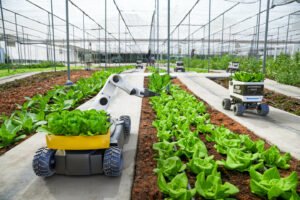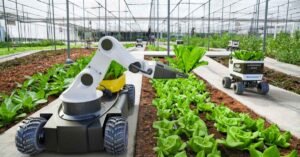Due to climate change and its severe impact on agriculture, the need for new, powerful farming methods has never been greater. Climate Smart Agriculture (CSA) shines a light of hope because it requires an integrated approach to combat the problems caused by climate change. This article discusses the ideas and methods behind climate-smart agriculture. It looks at how sustainability, resilience and productivity can be combined to make the future of global agriculture more secure and flexible.
Learn More About Climate-Smart Agriculture:
1. Triple Wins of CSA
It is very important for climate-smart agriculture to achieve ‘triple wins’. These include higher agricultural yields, better resilience to climate change and lower greenhouse gas emissions. The main goal is to create an agricultural system that can be maintained and changed.
2. Adjust, Mitigate and Get Things Done
CSA is built on three main pillars: production, adaptation and mitigation. It aims to make agricultural systems more resilient to weather changes, reduce the sector’s impact on climate change and increase yields to sustainably meet growing food demand.
3. Custom Solutions for Every Site
CSA’s philosophy is that solutions should fit every location. CSA emphasises a tailored approach that takes into account local climate conditions, soil types and the special needs of farming communities, knowing that climate change will affect different areas differently.
Core Practises of Climate-Smart Agriculture:
1. Conservative Tillage
Conservative farming is an important part of a CSA because it encourages crop rotation, consistent ground cover and minimal soil disturbance. These methods improve soil health, reduce runoff rates and increase water retention. This makes agricultural systems more resistant to extreme weather conditions.
2. Agriculture, Forestry and Animal and Plant Life
Agroforestry is the practise of integrating trees and different types of plants into agricultural environments. CSA supports this. Agroforestry increases wildlife populations, gives farmers more ways to make money and helps store carbon, reducing the effects of climate change.
3. Water-Saving Agriculture
Water-efficient agriculture is about using and managing water in the best possible way. CSA promotes the use of technologies such as drip irrigation, rainwater harvesting and precision gardening to make the most of water resources, especially in areas where water is scarce.
Benefits of Climate-Smart Agriculture:
1. Able to Cope with Weather Changes
CSAs make communities more resilient by growing a variety of foods, better managing water resources, and using agroecological practises. This helps farmers cope with the fact that climate-related events are happening more frequently and with greater intensity.
2. Burying Carbon Underground
Methods such as agroforestry and conservation agriculture help store carbon. As carbon sinks, trees and healthy soil help balance greenhouse gas pollution and absorb the effects of climate change.
3. A Better Way to Earn a Living
CSA helps farmers improve their living conditions by promoting sustainable and climate-resilient practises. Diversification, higher yields and the ability to enter new markets all give farmers more economic and social power.
Questions and Things to Think About:
1. Know and be Aware of
A major problem with many people using CSA is that they need to understand it. Farmers must be informed about the benefits of climate-smart practises and given the training they need to use them successfully.
2. Money Problems
Using climate-smart approaches often requires upfront costs. Farmers may not be able to afford to switch to more environmentally friendly farming methods or adopt new technologies. To solve this problem, we need financial incentives and assistance.
3. Policy Support
Policies that promote CSA at local, national and international levels are necessary to be effective. Governments are key to achieving climate-smart practises by formulating policies that reward and encourage climate-smart practises.
Innovation and the Way Forward:
1. Precision Agriculture and Digital Agriculture
CSA combines digital agriculture with precision agriculture technology and can develop in the right direction. Farmers can use sensors, drones and data analytics to make informed choices, maximise their resources and adapt to changing weather conditions.
2. Types of Climate-Adapted Crops:
It is important for CSAs to develop and promote crop varieties that can survive harsh climates. Research and breeding programmes can help develop crops that are resistant to climate stress. This will ensure food security even as the environment changes.
3. Cooperation with Other Countries
Climate change affects everyone, and collaboration with other countries is important to CSA’s success. Sharing knowledge, transferring technology and collaborating on projects can accelerate the use of climate-smart approaches around the world.
Case Studies on Climate-Smart Agriculture:
1. Climate-Smart Cities in Kenya
Kenya’s pilot programme for climate-smart villages shows that CSA technology is effective. Diversifying crops, introducing technologies that use less water and supporting agroforestry have made these communities more resilient and helped them earn more money.
2. Natural farming without budget in India
India’s zero-budget natural farming programme focuses on agriculture that does not use chemicals and is resistant to weather changes. This approach makes agricultural systems more sustainable by encouraging agro-ecological practises, organic inputs and water conservation.
3. Permaculture and forestry in Peru
Peru’s work on healthy agroforestry shows that planting trees on agricultural land can help. This technology supports CSA principles because it increases biodiversity, provides shade for crops and helps store carbon.
Conclusion:
As a sign of hope in the face of climate change, climate-smart agriculture offers an agricultural programme that is both sustainable and powerful. As the world grapples with growing problems caused by environmental change, a CSA approach is necessary. By encouraging new ideas, raising awareness, and creating policies that make things easier, we can build a world where agriculture can not only survive but thrive as the climate changes.
FAQs:
1. How does climate-smart agriculture (CSA) differ from conventional agricultural practises?
Unlike traditional agriculture, CSA focuses on achieving a “triple win”: increasing agricultural productivity, increasing resilience to climate change and reducing greenhouse gas emissions. It integrates sustainable, adaptive and productive practises to address the challenges of climate change.
2. How can climate-smart agriculture increase the resilience of agricultural systems?
CSA builds resilience by promoting practises such as diversification, improved water management and agro-ecological practises. These practises help farmers withstand the impacts of climate-related events, making agricultural systems more robust and adaptable.
3. What Role Does Carbon Sequestration Play in Climate-Smart Agriculture?
Carbon sequestration is an important aspect of CSA. Practises such as agroforestry and conservation agriculture help sequester carbon and act as a carbon store that offsets greenhouse gas emissions. This helps mitigate the effects of climate change on agriculture.
4. What are the challenges in adopting climate-smart agricultural practises?
Challenges include farmers’ need for knowledge and awareness, financial barriers to the adoption of new technologies and the need for supportive policies. Overcoming these challenges will require education, financial incentives and a policy environment conducive to climate-smart practises.
5. How can digital agriculture and precision agriculture contribute to climate-smart agriculture?
Digital farming and precision farming technologies play a critical role in CSA, providing farmers with the tools to make informed decisions. Sensors, drones and data analytics enable precise resource management, helping farmers adapt to changing climate conditions and optimise their agricultural practises.



